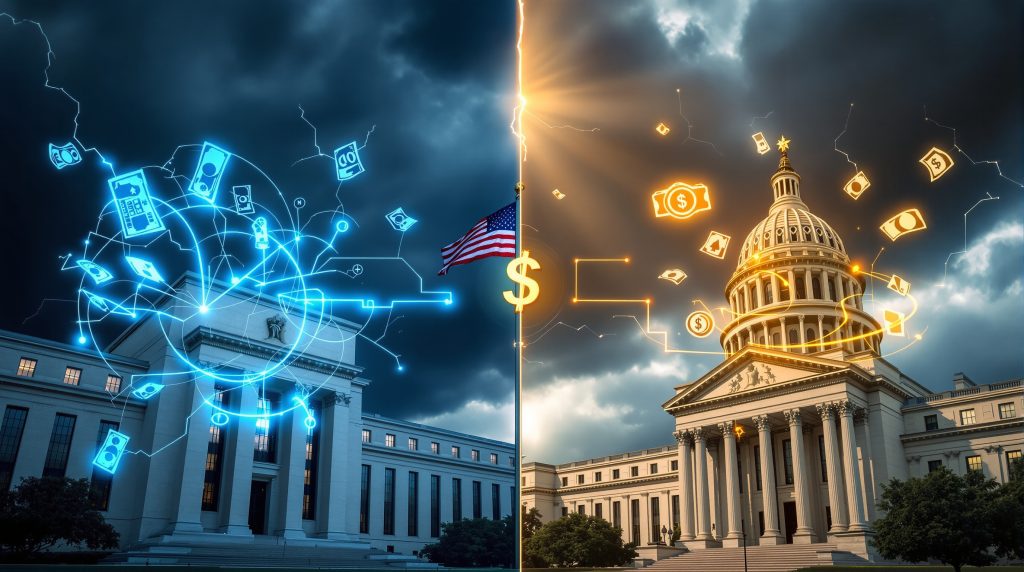The Federal Reserve and Treasury Relationship: A Complex Partnership
The relationship between the Federal Reserve and the U.S. Treasury represents one of the most consequential partnerships in American economic governance. While designed as separate institutions, their interconnected functions create a delicate balance of powers that influences everything from interest rates to government spending.
This institutional relationship combines independent monetary policy with fiscal management in a system that has evolved significantly since the Fed's creation in 1913. Understanding how these two powerful entities collaborate—and where their responsibilities diverge—provides crucial insight into the mechanics of America's economic system.
What is the Historical Foundation of the Fed-Treasury Relationship?
The Birth of an Uneasy Partnership
The Federal Reserve System emerged from the Banking Panic of 1907, when financial markets collapsed without a central authority to provide stability. The Federal Reserve Act of 1913 established a decentralized central banking system designed to prevent such crises, but its relationship with the Treasury wasn't clearly defined from the outset.
During these early years, the boundaries between Treasury functions and Federal Reserve responsibilities remained somewhat fluid. The Treasury maintained significant influence over monetary policy, while the Fed operated with limited independence.
Interestingly, historical records show that JP Morgan coordinated the first major bailout in 1907 using Treasury money to save preferred banks. This precedent established patterns of Treasury-private sector coordination that would later influence the Federal Reserve's creation and operational model.
The 1951 Treasury-Fed Accord: A Watershed Moment
The modern Fed-Treasury relationship was fundamentally shaped by the Treasury-Fed Accord of March 4, 1951. This pivotal agreement followed a period of tension during and after World War II, when the Fed had essentially surrendered its policy independence to help finance the war effort by maintaining artificially low interest rates on government debt.
The 1951 Accord freed the Federal Reserve from its obligation to support Treasury debt prices, establishing the principle of Fed independence in monetary policy decisions. This separation of powers remains a cornerstone of American economic governance, though the relationship continues to evolve.
Prior to this agreement, the Fed was required to purchase Treasury securities at fixed prices to support wartime financing needs. The Accord represented a critical turning point that established the precedent for central bank independence that continues to shape monetary policy today.
What Are the Distinct Roles of Each Institution?
The Federal Reserve's Core Functions
The Federal Reserve operates as America's central bank with three primary mandates:
-
Monetary Policy Implementation: The Fed adjusts interest rates and manages the money supply to promote maximum employment and stable prices—its dual mandate established by Congress in 1977.
-
Financial System Stability: The Fed supervises and regulates banks and other financial institutions to ensure system-wide stability and protect consumers.
-
Payment Systems Operation: The Fed provides financial services to depository institutions and helps maintain an efficient national payments system.
The Fed's policy decisions are made by the Federal Open Market Committee (FOMC), which consists of the seven members of the Board of Governors and five of the twelve Federal Reserve Bank presidents.
The Treasury Department's Domain
The Treasury Department serves as the financial arm of the executive branch with distinct responsibilities:
-
Fiscal Policy Management: The Treasury implements the government's tax and spending policies as directed by Congress and the President.
-
Debt Issuance and Management: The Treasury issues securities to finance government operations when expenditures exceed revenues.
-
Currency Production: While the Fed distributes currency, the Treasury's Bureau of Engraving and Printing produces physical currency and the U.S. Mint produces coins.
-
Tax Collection: Through the Internal Revenue Service (IRS), the Treasury collects taxes and enforces tax laws.
This separation of powers creates a system of checks and balances in economic policy, though practical operations often require significant coordination between the two institutions.
How Do the Fed and Treasury Coordinate Their Activities?
Operational Coordination
Despite their independence, the Fed and Treasury maintain extensive coordination in several key areas:
-
Debt Auctions: The Treasury issues debt through regular auctions, and the Federal Reserve serves as the Treasury's fiscal agent in conducting these auctions.
-
Payment Systems: The Fed processes government payments and receipts, essentially serving as the government's bank.
-
Cash Management: The Treasury maintains accounts at the Federal Reserve, which helps manage the government's cash position.
-
Foreign Exchange Operations: Since 1962, the Treasury and Fed have coordinated foreign exchange operations to ensure alignment with broader U.S. monetary and financial policies.
This coordination extends to international economic policy, where both institutions participate in forums like the G7 and G20 to represent U.S. interests in global market coordination.
The Treasury General Account
The Treasury General Account (TGA) at the Federal Reserve serves as the government's primary checking account. When the Treasury collects taxes or issues debt, the proceeds flow into this account. When it makes payments, funds flow out.
Changes in the TGA balance directly affect bank reserves in the financial system, creating a mechanical link between Treasury operations and the Fed's monetary policy implementation. This connection represents one of the most direct channels through which Treasury operations impact monetary conditions.
What Tensions Exist in the Fed-Treasury Relationship?
The Independence Question
The Federal Reserve's independence from political pressure remains a cornerstone of American monetary policy. However, this independence has faced challenges throughout history:
-
Political Pressure: Presidents have often expressed preferences for monetary policy, creating tension with the Fed's mandate for independent decision-making.
-
Crisis Management: During economic crises, the lines between monetary and fiscal policy can blur, as seen during the 2008 financial crisis and the COVID-19 pandemic.
-
Appointment Powers: The President appoints Fed governors and the Chair, subject to Senate confirmation, creating an indirect channel of influence.
The 14-year terms for Fed governors were specifically designed to provide independence from political cycles, though recent developments have raised questions about the extent of executive influence over Fed personnel decisions, as highlighted in research about USAID reform and Federal Reserve impact on inflation.
The Debt Management Dilemma
The Treasury's need to finance government operations and the Fed's responsibility for monetary policy can sometimes create competing objectives:
-
Interest Rate Impacts: The Fed's interest rate decisions directly affect the Treasury's borrowing costs, with each percentage point increase potentially adding billions to annual debt servicing costs.
-
Debt Sustainability Concerns: Monetary policy decisions that raise interest rates increase the government's debt service costs, potentially straining fiscal sustainability.
-
Market Signaling: Both institutions send signals to financial markets, sometimes with contradictory implications for investor behavior and economic expectations.
With the Federal Reserve currently holding approximately $6.3-6.4 trillion in assets on its balance sheet (down from nearly $9 trillion during the COVID-19 response), these tensions become particularly significant as inflation and debt challenges continue to mount.
How Did the Relationship Evolve During Economic Crises?
The 2008 Financial Crisis Response
The 2008 financial crisis marked a significant evolution in Fed-Treasury coordination:
-
Emergency Lending Programs: The Fed and Treasury collaborated on unprecedented emergency lending facilities to stabilize financial markets.
-
Troubled Asset Relief Program (TARP): While administered by the Treasury, this program required close coordination with the Fed's market operations.
-
Expanded Balance Sheets: The Fed's quantitative easing programs indirectly supported Treasury financing by purchasing government securities, expanding its balance sheet to $4.5 trillion from less than $1 trillion pre-crisis.
This period saw a dramatic expansion of both institutions' roles in managing economic stability, with the Fed taking on functions that blurred the traditional boundaries between monetary and fiscal policy.
The COVID-19 Pandemic Response
The pandemic response in 2020-2021 pushed Fed-Treasury coordination to new levels:
-
Joint Lending Facilities: The Treasury provided equity investments to back Fed lending programs under Section 13(3) of the Federal Reserve Act.
-
Fiscal-Monetary Coordination: Massive fiscal stimulus packages were complemented by the Fed's accommodative monetary policy.
-
Record Debt Issuance: The Treasury issued unprecedented levels of debt, while the Fed expanded its balance sheet to nearly $9 trillion—almost double its size after the 2008 crisis.
These crisis responses demonstrated how the traditional boundaries between monetary and fiscal policy can blur during extraordinary economic circumstances, raising important questions about institutional roles in future crises.
What Are the Accountability Mechanisms for Both Institutions?
Congressional Oversight
Both institutions answer to Congress, though through different mechanisms:
-
Fed Chair Testimony: The Federal Reserve Chair testifies before Congress at least twice annually on monetary policy and economic developments, often referred to as the Humphrey-Hawkins testimony.
-
Treasury Secretary Testimony: The Treasury Secretary regularly testifies on fiscal policy, financial stability, and international economic issues.
-
GAO Audits: The Government Accountability Office conducts audits of both institutions, though the Fed's monetary policy deliberations are exempt from GAO review.
These accountability measures provide a framework for democratic oversight while still preserving operational independence in day-to-day decision-making, as explained in the comprehensive Encyclopedia of Economics.
Transparency Requirements
Both institutions have increased transparency over time:
-
Fed Meeting Minutes and Projections: The Fed publishes detailed meeting minutes and economic projections to explain its policy decisions.
-
Treasury Borrowing Advisory Committee: The Treasury consults with this committee of market participants and publishes their recommendations.
-
Public Communications: Both institutions have expanded their public communications to explain policy decisions and economic perspectives.
These transparency initiatives help markets understand policy intentions while also supporting broader public confidence in economic governance.
How Might the Fed-Treasury Relationship Evolve in the Future?
Potential Areas of Change
Several factors could reshape the Federal Reserve and Treasury relationship in coming years:
-
Growing National Debt: As government debt continues to grow, questions about debt sustainability and the Fed's role in managing it may intensify.
-
Digital Currency Development: The potential introduction of a central bank digital currency would require unprecedented coordination between the Fed and Treasury.
-
Climate Risk Management: Both institutions are increasingly focused on climate-related financial risks, potentially creating new areas for coordination.
-
Critical Minerals Strategy: Recent policy developments, including the designation of silver and copper as critical minerals by the U.S. Geological Survey, highlight the growing intersection of economic security, defense needs, and critical minerals energy transition.
The addition of silver to the critical minerals list is particularly significant, as it occupies a unique position between monetary metals like gold and industrial metals like copper, serving both monetary and defense/industrial applications.
Governance Reform Proposals
Various proposals have emerged to modify the relationship between these institutions:
-
Independence Safeguards: Some advocate for stronger legal protections for Fed independence.
-
Expanded Coordination Mechanisms: Others suggest more formal coordination frameworks for crisis response.
-
Balance Sheet Policies: Questions about the appropriate size and composition of the Fed's balance sheet have implications for Treasury debt management and bond market dynamics.
Recent discussions about potentially "blending" Fed and Treasury operations to manage growing debt burdens represent a significant potential shift in this institutional relationship, with far-reaching implications for monetary policy independence.
How Does the Fed-Treasury Relationship Compare Internationally?
Global Central Bank Independence Models
The Fed-Treasury relationship exists within a spectrum of central bank arrangements globally:
-
European Central Bank: The ECB maintains greater statutory independence from national treasuries than the Federal Reserve.
-
Bank of England: The BOE operates with operational independence but under a mandate set by the Treasury.
-
Bank of Japan: The BOJ coordinates closely with the Ministry of Finance, with less formal independence than the Fed.
These different models offer alternative frameworks for balancing independence with coordination in monetary and fiscal policy.
International Coordination
Both the Fed and Treasury participate in international economic coordination:
-
G7 and G20 Meetings: Treasury Secretaries and central bank governors meet regularly to discuss global economic issues.
-
IMF and World Bank Governance: The Treasury leads U.S. participation in these institutions, while the Fed provides technical expertise.
-
Central Bank Swap Lines: The Fed establishes currency swap lines with other central banks, coordinating with Treasury on international financial stability.
This international dimension adds complexity to the relationship, as domestic policy decisions must often be balanced against global economic considerations.
A Delicate Balance of Powers
The relationship between the Federal Reserve and the Treasury Department embodies a careful balancing act between independent monetary policy and executive fiscal authority. While designed to operate separately, their functions inevitably intersect in ways that shape America's economic landscape.
This institutional partnership has evolved significantly since the Fed's creation, adapting to changing economic conditions, financial crises, and political pressures. Understanding the nuances of this relationship provides crucial insight into how economic policy is formulated and implemented in the United States.
As economic challenges continue to evolve, so too will this critical relationship—maintaining the delicate equilibrium between independence and coordination that has characterized American economic governance for over a century.
Looking ahead, the growing importance of hard assets and commodities in economic security policy may further reshape this relationship. The recent designation of silver and copper as critical minerals signals a fundamental shift in how the government approaches resource security, with implications for both monetary and fiscal policy, including the role of gold as inflation hedge in coming years.
Want to Stay Ahead of Market-Moving Mineral Discoveries?
Discovery Alert's proprietary Discovery IQ model delivers real-time notifications when significant ASX mineral discoveries are announced, helping investors capitalise on opportunities before the broader market. Explore how historic discoveries have generated substantial returns by visiting our dedicated discoveries page and start your 30-day free trial today.




